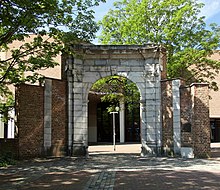Klosterrather Hof
The Klosterrather Hof , also called Klosterrather Refugium or Kirchrather Hof , was a former monastery courtyard and later a residential and manufacturing complex on Eilfschornsteinstrasse in Aachen .
history
The Klosterrather Hof had been the Aachen town house of the Klosterrath Abbey , Duchy of Limburg , since 1536 . After the city fire of Aachen in 1660, the property was significantly enlarged by the purchase of land, including along the Eilfschornsteinstrasse. By 1786 new buildings were built by the Aachen baroque master builder Joseph Moretti , including the still existing courtyard gate.
In 1802 the Klosterrather Hof fell to the French Republic in the course of the secularization of the departments on the left bank of the Rhine after a consular resolution of June 9th . During his visit to Aachen in September 1804, Napoleon personally sold the farm to the needle manufacturer Laurenz Jecker , who came from Alsace and was valued by him, for only 13,000 francs in order to support the establishment of a commercial enterprise there. Together with the brothers Jean-Baptiste Migeon from Grandvillers and Jean Vincent Victor Migeon from Charleville , Jecker set up a modern needle factory there, which with around 150 employees produced over a million pins a year and exported them to all of Europe. In 1809, after a crisis, Jecker withdrew from the company and sold his shares to the Migeon brothers.
In 1811 the brothers Johann Josef and Johann Heinrich Schervier , who already ran a copper farm on a neighboring property on the Templergraben , joined the company, now called Migeon et Schervier frères , as equal partners . In 1816 the Schervier brothers also took over the shares from Vincent Victor Migeon. From 1823 until his death in 1845, Johann Heinrich Schervier was the sole owner. His daughter, the founder of the order, Franziska Schervier , grew up in the house at Eilfschornsteinstraße 15.
In 1845 Ludwig Heinrich Schervier inherited the property and, after merging with Adalbert Kern, relocated his father's factory to Burtscheid as the scratch factory Kern & Schervier , but kept the property in Eilfschornsteinstrasse. Laurenz Jecker's son Julius Caesar Jecker (1820–1881) then took over the company buildings at Klosterrather Hof and in 1877 transferred them to the Heusch & Butenberg company . After the death of Ludwig Heinrich Schervier in 1896, his widow Franziska, née Hock, the property, which she sold to the machine manufacturer A. Schiffers in 1910 after Heusch & Butenberg had relocated their operations to the empty Lochner cloth factory .
During the Second World War, the Klosterrather Hof was destroyed and then largely removed. The land became the property of the State of North Rhine-Westphalia for use by RWTH Aachen University , which built a lecture hall complex ( Kármán Auditorium ) on it in 1977 . Only the archway from 1786 remained and was integrated into the design of the open space. The legend is widespread among students that the gate brings bad luck. Freshmen are told that they would not graduate if one went through the gate, which is why many students prefer to bypass the gate.
literature
- Joseph Gerhard Rey: The Schervier family and their clans , publications of the episcopal diocesan archive Aachen No. 1, ZDB -ID 846757-2 . Johannes Volk Verlag, Aachen 1936.
Web links
- Entry on the baroque gate of the Klosterrather Hof in the database " KuLaDig " of the Rhineland Regional Association
Individual evidence
- ↑ Marcel Bauer, Frank Hovens, Anke Kappler, Belinda Petri, Christine Vogt & Anke Volkmer: On the way on Couvens tracks . Grenzecho-Verlag, ISBN 90-5433-187-9 .
- ↑ Visual station Aachen (PDF; 1.9 MB)
- ↑ Step by step. Experience history (s) on foot. Volume 1: Aachen, Jülich, Heinsberg. Meyer & Meyer, Aachen 2008, ISBN 978-3-89899-446-0 .
Coordinates: 50 ° 46 ′ 37.5 " N , 6 ° 4 ′ 47.5" E


